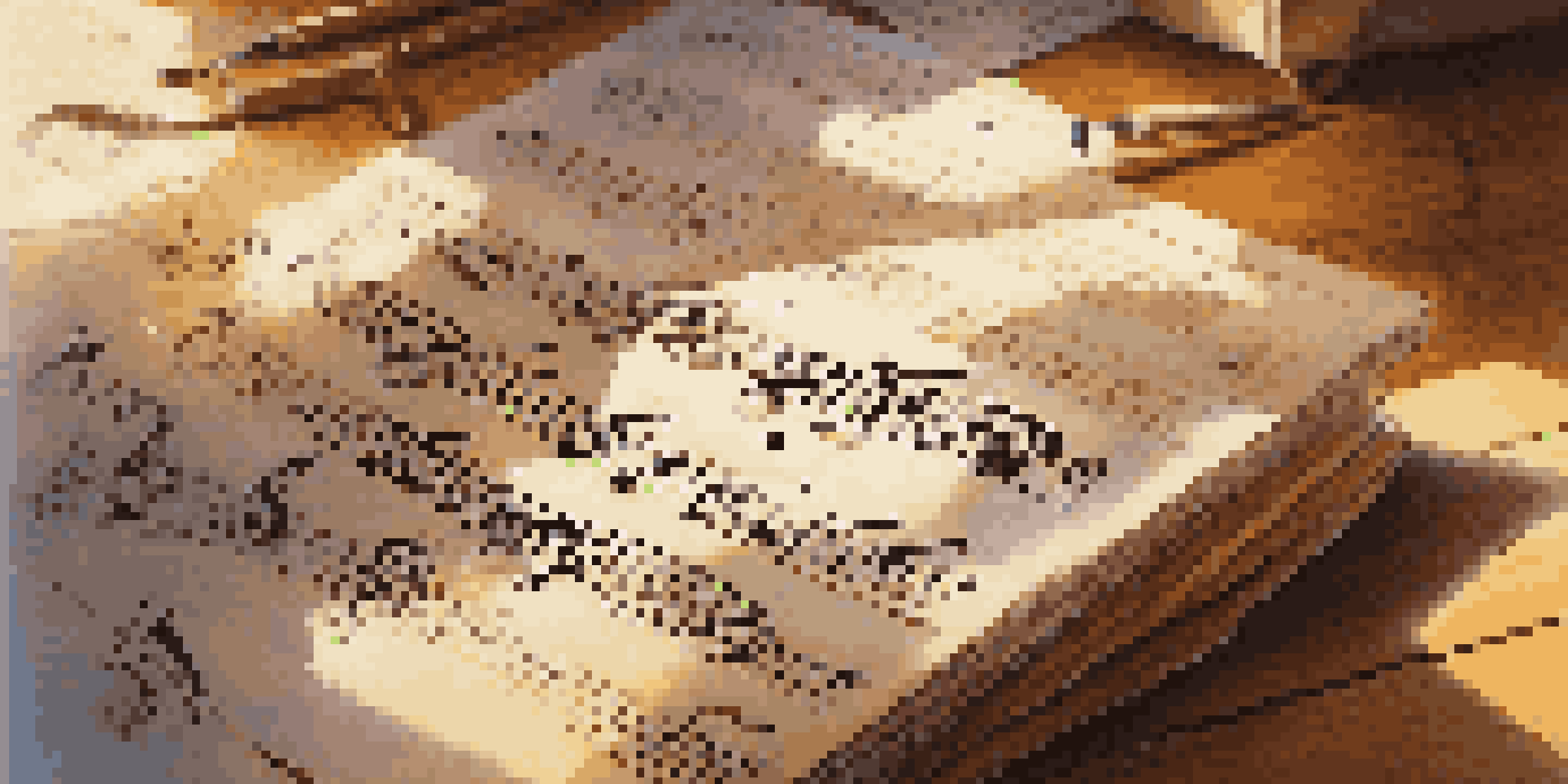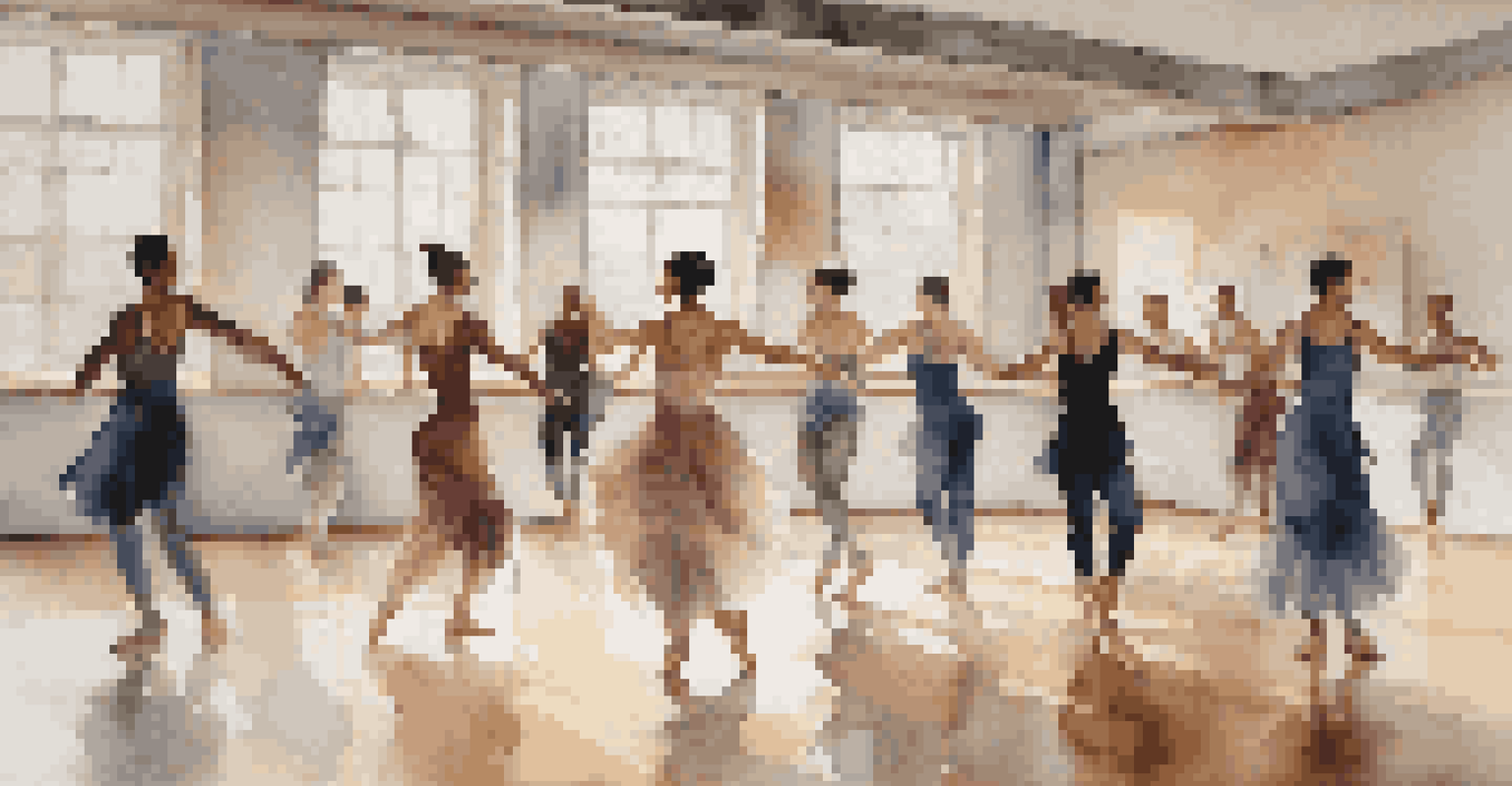Exploring the Symbolism in Dance Notation and Its Meaning

Understanding Dance Notation: An Overview
Dance notation serves as a written language for choreographers and dancers, enabling the preservation and communication of movement. It's like a map that guides dancers through the intricacies of a performance. By translating physical movements into symbols, notation captures the essence of dance, ensuring it can be revisited and reinterpreted over time.
Dance is the hidden language of the soul.
There are several systems of dance notation, including Labanotation and Benesh Movement Notation, each with its unique symbols and rules. Just as a musical score conveys the nuances of a symphony, dance notation encapsulates the subtleties of choreography. This structured form of representation allows for a deeper understanding of the art form.
Ultimately, dance notation is not just about recording steps; it's about capturing the emotional and narrative layers of a performance. By exploring these symbols, we can unlock the stories and feelings that dance conveys, transforming a fleeting moment into a lasting legacy.
The Role of Symbols in Dance Notation
Symbols in dance notation act as visual representations of movements, much like how letters form words. Each symbol carries specific meanings and instructions, guiding dancers through their performance. For instance, a simple symbol might indicate a jump, while a more complex one could encompass a series of turns and twists.

These symbols allow for a shared language among dancers and choreographers, making collaboration easier and more efficient. Imagine trying to explain a dance without any reference points; it would be like trying to navigate a new city without a map. Symbols help bridge the gap between different interpretations, ensuring everyone is on the same page.
Dance Notation Preserves Movement
Dance notation serves as a crucial tool for documenting and communicating choreography, allowing movement to be preserved and reinterpreted across time.
Moreover, the use of symbols can evoke emotions and imagery, enhancing the storytelling aspect of dance. Just as a painter uses colors to convey mood, choreographers use notation to articulate the emotional landscape of a piece, enriching the audience's experience.
Connecting Movement and Meaning in Dance
Dance is not just about physical expression; it's a profound form of storytelling. Each movement can symbolize a range of emotions, from joy to sorrow, and dance notation helps capture this richness. By analyzing the symbols, we can begin to understand the deeper meanings behind the choreography.
Every dance is a story told in movement.
For example, a graceful arm movement might symbolize longing or yearning, while a sharp, abrupt motion could represent conflict. When dancers interpret these symbols, they breathe life into the choreography, allowing the audience to connect with the emotions being expressed. This connection is what transforms a performance from mere movement into a compelling narrative.
Dance notation thus becomes a vital tool for exploring the relationship between movement and meaning. As we decode these symbols, we uncover layers of intention and emotion, inviting viewers to engage with the dance on a more profound level.
The Historical Context of Dance Notation
The practice of dance notation has a rich history, evolving alongside the art form itself. Early attempts at documenting dance can be traced back to the Renaissance, when choreographers sought ways to preserve their works. Just as written language evolved, so did the need for a systematic way to notate dance, leading to the development of various notation systems.
Historically, dance notation served practical purposes, such as teaching and preserving choreography for future generations. However, it also reflects the cultural and social contexts in which dance was created. Each notation system embodies the values and aesthetics of the time, offering insights into how dance has transformed through the ages.
Symbols Enhance Dance Collaboration
The use of symbols in dance notation creates a shared language that facilitates collaboration between dancers and choreographers, ensuring a unified performance.
By exploring the historical context of dance notation, we gain a deeper appreciation for its significance. It’s a testament to the enduring nature of dance as an art form, showcasing how it adapts and thrives across different cultures and eras.
The Intersection of Dance Notation and Technology
In recent years, technology has revolutionized the way we approach dance notation. Digital platforms allow for more dynamic and interactive ways to create, share, and analyze choreography. Imagine being able to manipulate symbols on a screen, making it easier to visualize complex movements and transitions.
These advancements enable choreographers to reach a wider audience, breaking geographical barriers. Online notation software allows dancers from different parts of the world to collaborate seamlessly, sharing their interpretations and insights. This interconnectedness fosters a global dance community, enriching the art form as a whole.
Additionally, technology provides new opportunities for archiving and preserving dance works. Video recordings combined with digital notation create a comprehensive record that transcends time, ensuring that future generations can experience and learn from the past.
Symbolism in Dance Notation: A Deeper Exploration
Delving deeper into the symbolism within dance notation reveals layers of meaning that resonate with both performers and audiences. Each symbol can evoke personal interpretations, much like how a piece of art can inspire varied emotional responses. This subjectivity creates a rich tapestry of understanding, making dance notation a powerful tool for expression.
For instance, a circular symbol might represent unity or wholeness, while a zigzag could signify chaos or unpredictability. By exploring these associations, dancers can connect more profoundly with their movements, infusing their performances with intentionality and depth. This exploration fosters a sense of ownership and authenticity in their interpretations.
Technology Transforms Dance Notation
Advancements in technology offer innovative ways to create, share, and preserve dance notation, fostering a global community and enriching the art form.
Ultimately, the symbolism in dance notation invites us to reflect on our own experiences and emotions. It encourages performers and audiences alike to engage with the art form in a meaningful way, transforming a simple performance into a shared journey of exploration and discovery.
The Future of Dance Notation and Its Symbolism
As dance continues to evolve, so too will the practices surrounding dance notation. Emerging trends suggest a shift towards more inclusive and diverse systems that better reflect the global nature of dance. This evolution presents exciting opportunities to incorporate different cultural symbols and movements into the notation landscape.
Furthermore, the integration of technology will likely play a pivotal role in shaping the future of dance notation. As virtual reality and augmented reality become more prevalent, we can expect innovative ways to experience and interpret dance. These advancements promise to enhance our understanding of movement, allowing us to engage with choreography like never before.

In this ever-changing landscape, the symbolism inherent in dance notation will remain a vital thread, connecting past, present, and future. As we continue to explore and innovate, we will uncover new meanings and interpretations, ensuring that dance notation remains a dynamic and relevant aspect of the art form.